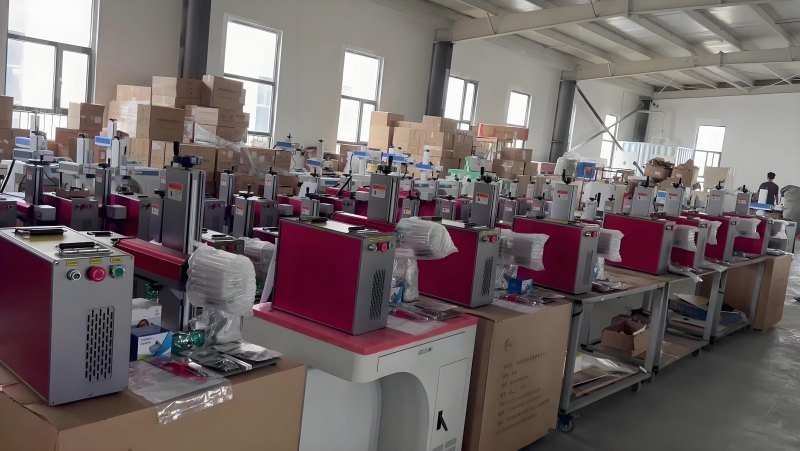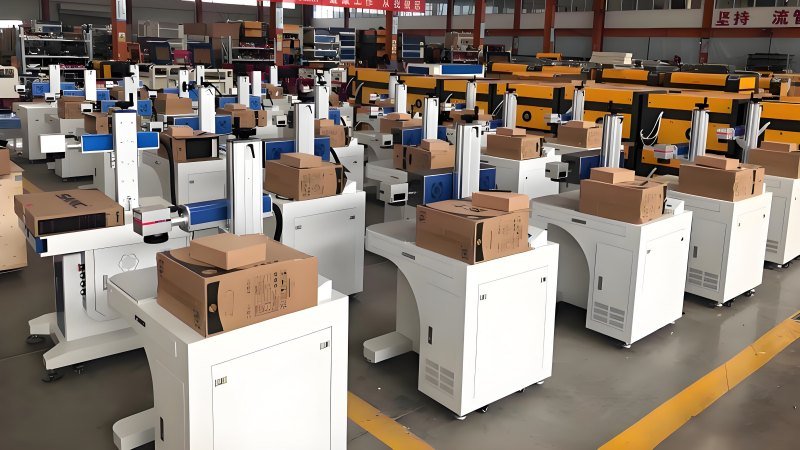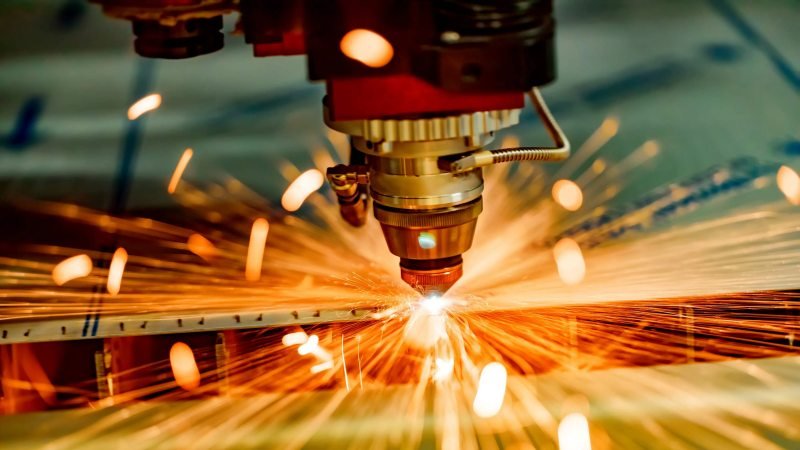Abstract
This article provides an in-depth exploration of laser marking machines, detailing their working principles—from laser generation, beam transmission and focusing, to material interaction. It introduces various working modes and analyzes the characteristics of different types of laser marking machines. The core advantages, including high precision, non-contact processing, durability, flexibility and programmability, and environmental cleanliness, are elaborated. Combined with applications across industries, this article demonstrates the value of laser marking machines, offering a comprehensive overview of their critical role and broad prospects in modern industry and beyond.
1. Introduction
In today’s rapidly evolving technological landscape, the demand for product identification and marking has become increasingly diverse and sophisticated. From tiny serial numbers on electronic products to traceability codes on automotive components and intricate patterns on artworks, precise, clear, and durable marking has become a key requirement across numerous industries. As an advanced marking device, the laser marking machine is gradually replacing traditional marking methods with its superior performance and unique advantages, ushering in a new era of precision marking. It is not only widely used in industrial manufacturing but also demonstrates enormous potential in electronics, healthcare, jewelry, packaging, and many other sectors, providing strong support for product personalization, quality traceability, and brand building.
2. Principle of Laser Marking Machines
2.1 Laser Generation
A core component of laser marking machines is the laser source. Common types include Nd:YAG lasers, CO₂ lasers, and fiber lasers. Take the Nd:YAG laser as an example: it uses a pump source to inject energy into a yttrium aluminum garnet (YAG) crystal doped with neodymium ions (Nd³⁺). This causes the Nd³⁺ ions to undergo energy level transitions, forming a population inversion and generating stimulated radiation, which outputs a laser beam at a wavelength of 1.06 μm. CO₂ lasers, on the other hand, utilize CO₂ gas discharged in a tube, causing molecular energy level transitions to produce a laser at 10.6 μm. Different laser types exhibit distinct characteristics due to their working materials and excitation methods, making them suitable for various materials and marking requirements.
2.2 Beam Transmission and Focusing
The generated laser beam is transmitted and focused through a series of optical components. First, the beam passes through a beam expander to increase its diameter, reducing divergence and improving collimation. It then reflects off mirrors to redirect the optical path toward the marking area. Finally, a focusing lens concentrates the laser energy into an extremely small spot on the material surface, often in the micrometer range, creating extremely high energy density.
2.3 Interaction with Materials
When the high-energy-density laser spot acts on the material surface, it triggers multiple physical and chemical reactions. For metal materials, the laser energy rapidly heats the surface to melting or boiling points, causing partial vaporization and forming tiny pits or protrusions for marking. For non-metallic materials like plastics and wood, the laser energy may induce chemical reactions such as carbonization or color change, or cause local melting and evaporation to create clear marks. For example, when marking plastic surfaces, the laser energy alters the molecular structure of the plastic, leading to color changes and visible marks. This precise interaction with materials enables laser marking to achieve high-quality results on various surfaces.
3. Working Modes of Laser Marking Machines
3.1 Mask Marking
Also known as projection marking, this mode uses a system comprising a laser, a mask plate, and an imaging lens. The laser beam, expanded by a telescope, uniformly illuminates the pre-fabricated mask plate. Light transmits through the etched areas of the mask, and the mask’s pattern is imaged onto the workpiece surface (focal plane) via the lens. Typically, a complete mark is formed in a single laser pulse. The irradiated material surface is rapidly heated, vaporized, or chemically altered in color to create a distinguishable mark. Mask marking commonly uses CO₂ and YAG lasers. Its advantage lies in high speed—one laser pulse can mark a complete symbol with multiple characters, suitable for mass production line marking. However, mask plates are costly to produce and inflexible for content changes.
3.2 Array Marking
Array marking employs multiple small lasers to emit pulses simultaneously. After reflection and focusing, these pulses ablate (melt) uniformly sized and deepened small pits on the material surface. Each character or pattern is composed of these small circular pits, typically arranged in a 5×7 matrix (5 dots for horizontal strokes, 7 for vertical strokes). This method usually uses low-power RF-excited CO₂ lasers, with a marking speed of up to 6,000 characters per second, making it ideal for high-speed online marking. However, it is limited to dot-matrix characters with low resolution (usually 5×7), performing poorly for complex characters like Chinese characters and unable to mark vector graphics.
3.3 Scanning Marking
The scanning marking system consists of a computer, laser, and x-y scanning mechanism. It works by inputting marking information into the computer, which controls the laser and scanning mechanism to move high-energy laser spots—transformed by a special optical system—across the workpiece surface to form marks. The x-y scanning mechanism mainly comes in two types: mechanical scanning and galvanometric scanning.
- Mechanical Scanning: Unlike changing mirror angles to move the beam, mechanical scanning translates the mirror along x-y coordinates to alter the laser’s position on the workpiece. For example, the laser beam reflects off a mirror and passes through a focusing lens to the workpiece. A plotter arm moves the mirror along the x-axis, while the focusing lens (fixed with an upper mirror) moves along the y-axis. Under computer control, their combined motion enables the laser to reach any point on the plane for marking. This method is simple and low-cost but slow, less precise, and prone to mechanical wear.
- Galvanometric Scanning: This system comprises a laser, x-y galvanometric mirrors, a focusing lens, and a computer. The laser beam reflects off two mirrors (galvanometers) controlled by the computer to adjust their angles. These mirrors scan along the x and y axes, deflecting the laser beam to move a high-power-density focal spot across the material surface according to design requirements. The focal spot can be circular or rectangular. Galvanometric scanning typically uses continuous-wave Nd:YAG lasers (1.06 μm wavelength, 10–120W power), with continuous or Q-switched output. It offers wide application, supporting vector and dot-matrix marking with adjustable marking areas. Features like fast response (hundreds of characters per second), high marking quality, sealed optical paths, and strong environmental adaptability have made it the mainstream marking method.
4. Core Advantages of Laser Marking Machines
4.1 High Precision Marking
Laser marking machines achieve micron-level precision, clearly and accurately marking tiny serial numbers, QR codes on electronic components, and complex patterns on precision mechanical parts—far exceeding traditional mechanical or inkjet marking. For example, marking tiny characters on electronic chips ensures consistency and clarity, meeting the strict high-precision identification requirements of the electronics industry. This precision not only enhances product appearance but also provides a solid foundation for quality traceability and anti-counterfeiting.
4.2 Non-Contact Processing
During laser marking, the laser beam does not physically contact the workpiece, avoiding mechanical stress and wear from traditional contact marking. This prevents scratches or deformation on the workpiece surface, making it suitable for materials requiring high surface quality, such as fragile glass, hard ceramics, and sensitive optical components. Non-contact processing also reduces equipment maintenance costs and precision degradation due to mechanical wear.
4.3 Strong Durability
Laser-marked marks exhibit excellent durability. Through physical or chemical interactions with the material surface, the marks form a permanent bond, resisting wear, corrosion, and high temperatures. Even in harsh environments like high heat, humidity, or strong acids/bases, laser marks remain clear throughout the product’s lifecycle. For instance, laser marks on automotive engine components stay legible despite long-term high-temperature, high-pressure, and vibration conditions, ensuring reliable traceability and after-sales service.
4.4 Flexibility and Programmability
Laser marking machines offer high flexibility and programmability. Marking content—including text, patterns, barcodes, and QR codes—can be easily designed or modified via computer software. They adapt to both personalized small-batch production and standardized large-scale manufacturing. Additionally, they can mark on workpieces of various shapes and sizes by adjusting laser parameters and scanning paths, enabling marking on complex curved surfaces and irregular objects. In the jewelry industry, for example, they can engrave personalized patterns or text on gemstones of any shape, adding unique value.
4.5 Environmental Friendliness
Unlike traditional marking methods like inkjet printing (which uses large amounts of ink containing volatile organic compounds, VOCs, harmful to the environment), laser marking is eco-friendly. It produces no chemical pollutants or waste and requires no consumables like ink or solvents, reducing environmental harm and aligning with modern green manufacturing standards. It also lowers costs associated with consumable procurement and waste disposal.
5. Application Cases Across Industries
5.1 Electronics Industry
In electronics, laser marking machines are widely used to mark casings, motherboards, and chips of mobile phones, computers, and tablets. For example, marking brand logos, model numbers, and serial numbers on mobile phone casings ensures both aesthetic appeal and anti-counterfeiting. On chips, laser marking tiny information like model numbers, production dates, and batch codes facilitates production, testing, and quality traceability.
5.2 Automotive Industry
The automotive industry has strict traceability requirements for components. Laser marking machines label critical parts like engine blocks, transmissions, and frames with unique identification codes, production dates, and batch numbers. These marks remain clear throughout the vehicle’s lifecycle, aiding manufacturers in quality control and recall management. Laser marking also creates exquisite patterns on interior components, enhancing aesthetics and texture.
5.3 Healthcare Industry
The healthcare sector demands the highest standards of safety and quality. Laser marking machines are crucial for medical devices and drug packaging. They mark specifications, production dates, expiration dates, and batch numbers on disposable medical devices like syringes and infusion sets to ensure traceability. On drug packaging, they label critical information like drug names, dosages, and expiration dates, preventing counterfeiting and ensuring patient safety.
5.4 Jewelry Industry
The jewelry industry values personalization and uniqueness. Laser marking machines engrave intricate patterns, text, names, or special dates on jewelry like rings, necklaces, and bracelets, adding exclusive value. Their high precision and durability ensure the engravings remain intact and vibrant during long-term wear.
5.5 Packaging Industry
In packaging, laser marking machines label product information, barcodes, and QR codes on boxes and labels. They quickly and accurately mark various materials like paper, plastic, and metal foil, improving production efficiency and quality. The clarity and durability of laser marks also aid product identification and traceability in the supply chain.
6. Conclusion
Laser marking machines have become increasingly vital in modern industry and beyond, thanks to their advanced principles, diverse working modes, and exceptional core advantages. They not only meet the demand for precise and high-quality marking but also offer efficient, eco-friendly, and flexible production solutions. As technology advances, laser marking machines will continue to improve in performance and expand into new applications. In the future, they are poised to shine in emerging fields like new energy, 3D printing, and smart wearables, driving the development of precision marking technology and injecting new vitality into innovation across industries—unlocking an even more brilliant new era of precision marking.



